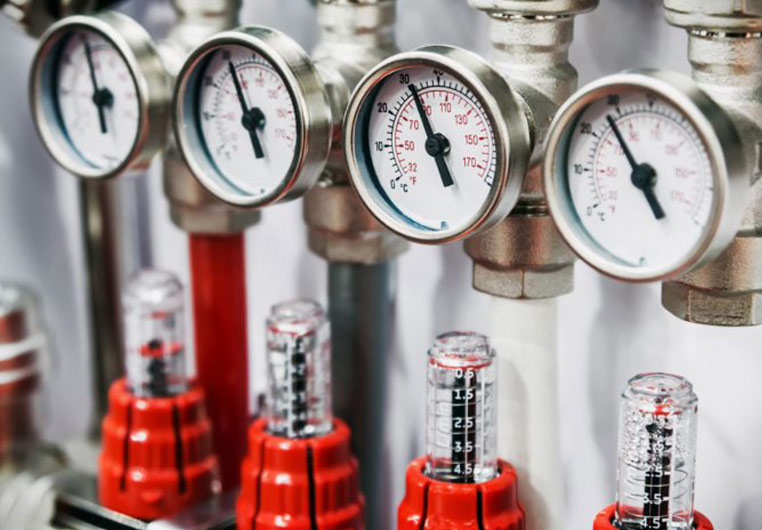
Solenoid Valves FAQs
Why is a solenoid valve used?
A solenoid valve is used to control the flow of a fluid – including both gases and liquids – through a pipe. There are different types of solenoid valves. Some have more than one inlet or multiple outlets, allowing them to divert flow or choose between several different fluids.
How do solenoid valves work?
A solenoid is an electromagnet. When the electric current through the solenoid’s wire coil changes, a magnetic field is created. This is then used to drive a magnetic armature or plunger to open or close the valve. This movement can be helped or opposed by a spring or by the pressure of the fluid in the valve.
How many types of solenoid valves are there?
There are a numerous range of solenoid valves. They are defined by the number of inputs and outputs, whether they are open or closed in the default position, and whether the fluid pressure range acts against the movement of the piston or armature, or is used to support the direction of motion.
Why do solenoid valves fail?
Solenoid valve failure can be caused by a variety of issues. Sometimes the high pressure fluid acting against the movement of the armature is greater than the electromagnetic force driving it. Electrical faults can also be to blame – for example, a loss of mains power, incorrect voltage selection, or a damaged solenoid coil. We supply replacement solenoid valves for the Pilot Gas Monitoring System and Gas Valve Controller.
What is the symbol for a solenoid?
The basic symbol for a solenoid is a square with a diagonal line inside. This shows the energised state of a valve and is usually used along with a spring symbol to denote the rest state. Between the two are further squares that show the states of the valve, with a small T denoting a closed port and an arrow to show the direction of flow.
What happens when a solenoid fails?
A failed solenoid will not function when it is energised by a current. This may simply mean that it remains in the default state. In cases of structural failure in the valve, a leak may occur. However, it is often just a case of insufficient current or a damaged coil.
What is a solenoid and how does it work?
The general purpose of a solenoid is to use electromagnetic induction to produce motion. An electric current passes through a coil, which in turn generates a magnetic field. This drives a magnetic lever or piston to open or close the valve. ‘Solenoid’ is the name for both the wire coil and the device as a whole.
How much does a solenoid cost?
Solenoid prices can vary. More complex and more powerful solenoid valves typically cost more. It’s important to get the right solenoid valve for each application. For example, piloted solenoid valves are designed for use when the fluid pressure would be too great for a direct solenoid valve to operate.
What is a solenoid simple definition?
The simplest definition of a solenoid is a coil of wire that generates a magnetic field when a current passes through it. However, ‘solenoid’ also refers to complete devices that use this effect to drive a piston, lever or armature, such as in a solenoid valve.
What is an example of a solenoid?
The most common example of a solenoid is in a car ignition. Here it’s used to turn on the starter motor, which in turn starts the engine. Solenoid valves are widely used to control fluid flow. In the home this includes appliances like washing machines.
How do you test a solenoid?
An easy way to test a solenoid is to activate it and see if the armature moves as expected. Failure could mean the valve is not big enough for the task or that the solenoid is damaged. Complete systems like the Pilot Gas Alarm include built-in test functions too.
What are the three types of solenoids?
Three main types of solenoids include direct, internally piloted and externally piloted solenoid valves. Direct solenoid valves are driven against the flow pressure of the fluid. Internally and externally piloted solenoid valves use the fluid or a separate medium to support the direction of motion so the fluid pressure does not prevent operation.
What is 5/3 way solenoid valve?
A 5/3 way solenoid valve is a fairly complex valve with two solenoids, five ports and three possible states. Each solenoid controls a valve state, while the default configuration returns the valve to the central position when neither solenoid is pressurised.
What is the main function of a solenoid valve?
Solenoid valves control fluid flow. Their default state can be to either allow a gas or liquid to flow, or to prevent flow. When energised, the valve moves to the other position. They are often used in monitoring systems like the Pilot Gas Alarm to shut off a gas supply when a leak is detected.
What are the parts of a solenoid?
A solenoid contains a wire coil around a magnetic core. When a current flows through the coil, the induced magnetic field drives the core, which can in turn move a piston or armature. A solenoid valve also contains several ports through which fluid can flow, and may contain a spring to support or resist the armature’s motion.
Which wire is used in solenoid?
The common type of wire used in solenoids is called ‘magnet wire’. This is copper wire with a very thin clear coating of insulation. The insulation prevents a short circuit across the loops on the coil. Aluminium wire can also be used as long as the windings are insulated from one another.
Does a solenoid have positive and negative?
The magnetic field in a solenoid has a north pole, but the polarity of a solenoid valve does not matter. That’s because the polarity induced in the core of the solenoid reverses if the current in the coil reverses, so the motion of the core is the same either way.
Are solenoids AC or DC?
Solenoids can work on both AC and DC current. However, an AC solenoid can differ in design from a DC solenoid. With AC, the constantly changing current can cause vibrations in the core. Smoothing systems are used to counteract this, but these are not needed in DC solenoids.
Where is the solenoid valve located?
On a Pilot Gas Alarm, the solenoid valve is installed downstream of the regulator and as near to it as possible. This ensures that when the solenoid valve is closed, as much of the pipe as possible is empty of gas. It should be wired to pins 9 and 10 on the PCB.
How fast can a solenoid operate?
The speed of a solenoid valve depends on factors like the fluid pressure differential and the strength of the induced magnetic field, but in most cases a solenoid operates very quickly, around a tenth of a second or less, and much faster than manual shut-off valves.
What happens when the solenoid goes bad?
A faulty solenoid will fail to operate or may only partially close the valve. On the Pilot Gas Alarm you can test this using the gas on/off button, which should manually activate the solenoid valve. Replacement solenoid valves are available if required.
What is a solenoid driver?
A solenoid driver is a device that acts as a solenoid controller. It can perform several functions, such as activating multiple solenoids at once, or reducing the current once a solenoid has overcome the initial higher resistance of fluid pressure, while still keeping it in the activated position.
What is a 3/2 solenoid valve?
A 3/2 solenoid valve has three ports and two possible states. In the open position, the inlet port flows to the outlet port. When closed, the valve diverts the inlet to an exhaust port. A 3/2 solenoid valve can be normally open or normally closed as required.
How does a 2 way solenoid valve work?
A simple 2 way solenoid valve has two ports, an inlet and an outlet. When the valve is open, fluid flows through from the input to the output. When the valve is closed, the flow is physically blocked. A 2 way solenoid valve may be either open or closed in the default state.
What is a pilot operated solenoid valve?
A pilot operated solenoid valve uses a medium to drive the motion of the actuator or piston, which helps the valve to function in applications where the fluid pressure would be too great for a direct valve to be used. This medium may be the fluid itself (internally piloted) or an independent medium (externally piloted).
What is pneumatic solenoid valve?
Pneumatic relates to gases, whereas hydraulic relates to liquids. A pneumatic solenoid valve, therefore, is a solenoid valve used to control the flow of a gas. Solenoid valves are used in both hydraulic and pneumatic systems, often interchangeably.
How do you turn on a solenoid valve?
A solenoid valve contains an electromagnet and must be connected to an electric current in order to work. When a current passes through the solenoid, a magnetic field is generated around the coil and this activates the valve. Solenoids can use AC or DC current with slight differences in design between the two types.
How do you open a solenoid valve?
Solenoid valves may be ‘normally open’ or ‘normally closed’. In a normally open solenoid valve, the valve will be open when the current is turned off and it is in the default position. In a normally closed solenoid valve, the solenoid must be activated and the piston moved to open the valve.

